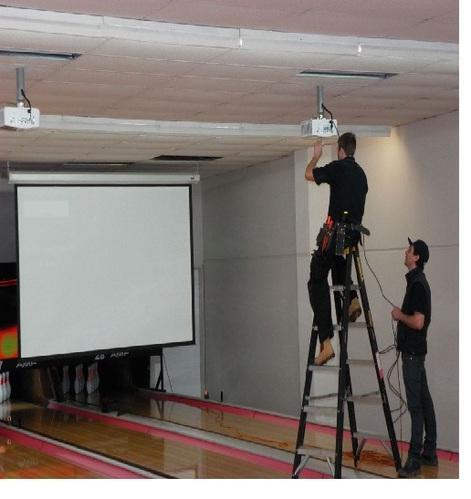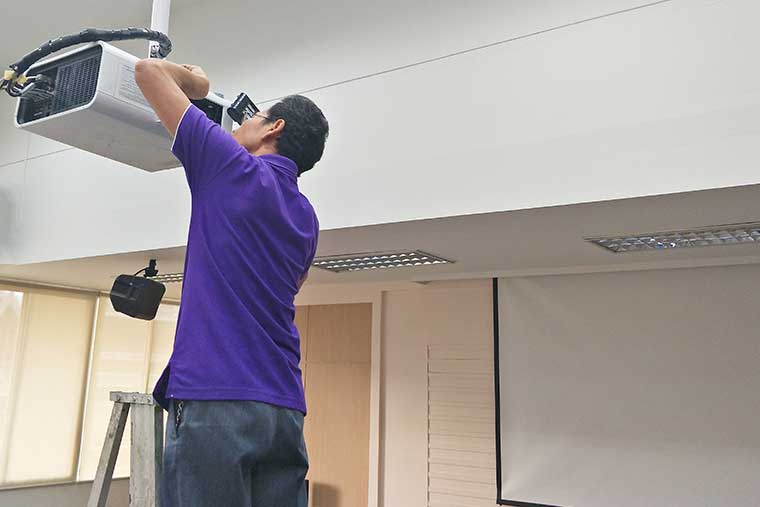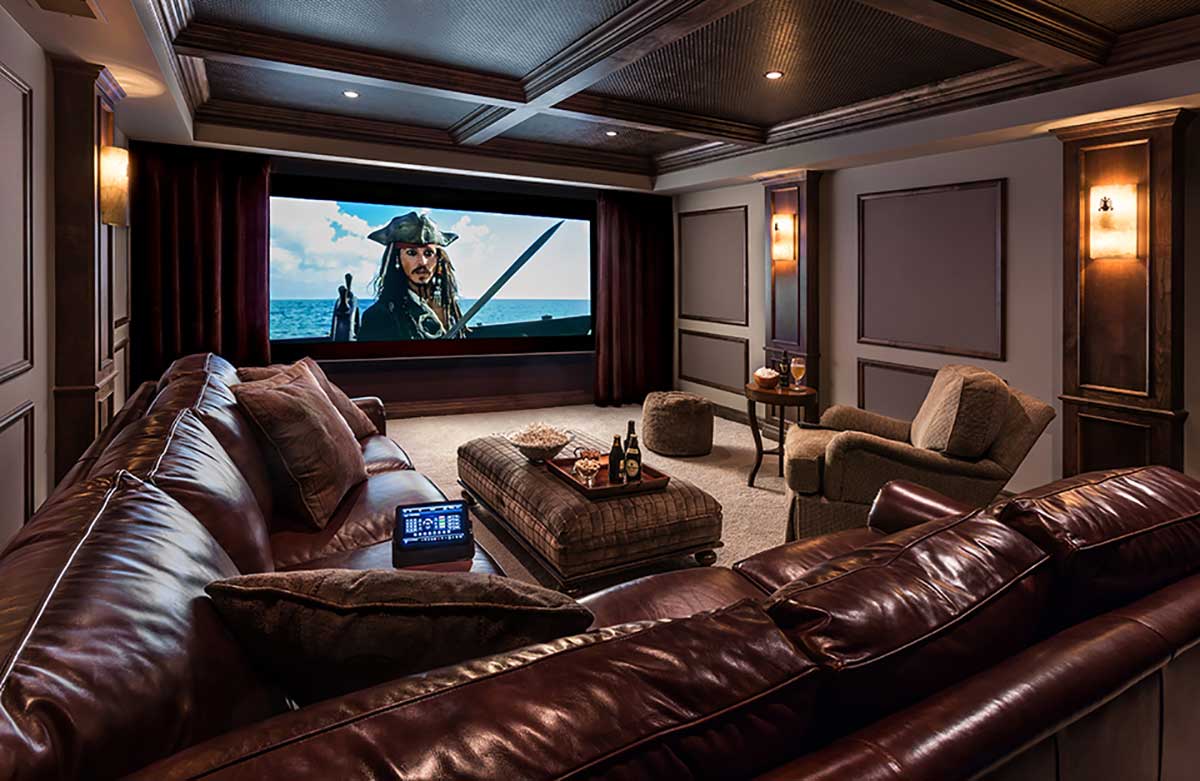Exploring Cinema-Quality Projector Screen Installation
Step into the realm of high-definition projector screen installation, essential for every home theater. These screens elevate your viewing enjoyment while safeguarding your valuable projector from dust and environmental factors. Choosing the perfect projector screen requires careful consideration of key factors like size, aspect ratio, gain, and viewing angle. Our goal is to guide you through the selection process to ensure your home theater delivers a cinematic experience akin to the movie theater.
which are like the shapes of your screens. Imagine them as the canvas for your visuals. The popular ones are 16:9, perfect for wide movie experiences, and 4:3, often seen in computer and projector setups. The key here is to match your screen’s aspect ratio with what your projector can handle. It’s like ensuring the puzzle pieces fit perfectly for the best viewing experience.

Your screen’s dimensions should complement your room’s size and the distance from your seating area to the screen. It’s about crafting an immersive cinematic atmosphere within your personal space.
Gain quantifies the light your screen reflects. Opt for higher gain screens in well-lit rooms, while lower gain screens suit darker spaces. Tailor your choice to your room’s lighting conditions for the best viewing experience.
So, whether you’re setting up a cozy home theater or a dedicated cinema space, the right projector screen installation can make all the difference. We’re here to help you make the best choice for your cinematic adventures.
Benefits of Your Own Home Theater
Nielsen estimates that, in the United States alone, 116.4 million households own a TV. Having a television can be useful for watching shows on cable, looking up funny YouTube videos or playing on a video game console. Turning part of your house into your own personal theater just takes all those perks to the next level.
One of the advantages of having a home theater is that you’ll save on entertainment expenses in the long run. Sure, you may get sticker shock from the price tag on a larger TV, better speakers or even new wiring, but going out frequently adds up faster than you might think. Movie tickets cost a boatload nowadays, not to mention the soda, popcorn and candies you end up purchasing while you’re there. Watching films from the comfort of your home with your preferred snacks on hand is so much sweeter!
Putting together a home theater is a lifestyle improvement. It’ll completely transform your evenings in, and it’ll make a great selling point if you intend to move in the future. The electric wiring you install, cables you connect, internet upgrades you make and any other fixtures that go along with the setup will increase the value of your home and look good in the eyes of potential buyers.
Key Considerations for Your Cinema-Quality Projector Screen
When on the hunt for a cinema-quality projector screen, certain factors deserve your attention. Firstly, size matters; a larger screen amplifies immersion. Secondly, scrutinize the screen’s resolution, as higher resolutions yield sharper images.
Irrespective of your screen choice, prioritize designs that minimize light reflection, delivering a realistic and immersive viewing experience.
Lastly, opt for a projector screen from a reputable manufacturer offering warranties. This ensures lasting quality, promising years of cinematic excellence in your home theater setup. With these factors in mind, you’ll find the perfect projector screen installation to elevate your cinematic adventures.
Cinema-Quality Projector Screen Types: A Guide
There are several different varieties of cinema-quality projector screens, each with a different set of advantages and factors to take into account. To assist you in selecting the ideal screen type for your home theater setup, let’s examine the most common screen types:
Fixed Frame Projector Screens: This screen is a popular choice for home theater systems because they provide a stylish and simple installation option. Black backing is a common feature of fixed-frame displays to reduce light leakage and improve contrast.
Projector screens that are motorized: If automation is what you’re after, these may be adjusted remotely and frequently have height and aspect ratio options. Remember that they are typically more expensive than fixed-frame screens.
Portable Projector Screens: Don’t be fooled by their compact size; these screens deliver impressive picture clarity and contrast. They’re perfect for those on the move or seeking a quick and easy setup.

Rear Projection Panels: When you require a permanent setup but have limited space, these screens come to the rescue. They excel in contrast and offer versatility in placement. Keep in mind that they usually come at a higher cost and demand specific projection equipment.
Curved Projector Screens: For dedicated home theaters aiming for an immersive experience, curved screens provide a broader field of view. While their design may require specialized installation, the payoff is superior image quality and extensive customization options.
Outdoor Projector Screens: Designed for outdoor use, these screens create unforgettable outdoor movie nights. Crafted from UV-resistant materials, they’re weatherproof and produce vibrant, bright images even in direct sunlight.
Tripod Projector Screens: When versatility is key, tripod screens come into play. They’re lightweight, portable, and a breeze to set up in various locations. Assembling them is a cinch, making them perfect for your travels and changing setups.
With these additional projector screen choices, you’re well-prepared to select the perfect fit for your home theater adventures.
Essential Steps for Effective Projector Setup
Start with a High-Quality Screen: A successful projector installation hinges on a quality screen that ensures a vibrant, clear image. A well-matched screen, in terms of aspect ratio, distance, and installation height, is key. Consider renting a projector and screen to ensure compatibility.
Consider the Location: The projector’s placement is paramount. For larger images, ample space is necessary, and be vigilant about obstructions that may block the projector’s beam. Ceiling mounting can be a practical solution when needed.
Get the Height Right: Proper projector height is crucial for image integrity. Whether it’s ceiling-mounted, on a truss, or resting on a table, precise height adjustment is essential to align with your screen.
Choose the Correct Aspect Ratio: Optimize your viewing experience by matching the projector’s aspect ratio to your screen size. Common ratios like 16:9 for home theaters or 4:3 for TV monitors offer versatile options.
Leverage Alignment Images for Precision: Utilize alignment images to fine-tune the projector’s height, distance, and lens focus, ensuring a sharp, edge-to-edge display.
Ensure Clarity with Zoom and Focus: Employ the projector’s zoom and focus features to achieve a well-proportioned image that remains steady. If clarity eludes you, contemplate resizing the projector to align with your screen.
Select the Right Picture Mode: Experiment with preset picture modes like ‘Cinema Mode’ or ‘Movie Mode’ to identify optimal settings. Exercise caution in modes that may escalate fan noise.
Fine-Tune 3D Settings: Elevate image quality with 3D content by adjusting 2D and 3D settings as needed. Each projector boasts unique features to enhance viewing quality.
Adjust Brightness and Contrast: Adapt brightness and contrast settings in accordance with ambient lighting conditions. Choose a projector with lumens that match your environment – more lumens for well-lit areas and fewer for dim spaces.
Conduct an Audio Check: Don’t overlook audio testing. While built-in speakers suffice for small presentations, larger events and home theaters benefit from dedicated sound systems like surround sound. Explore wireless audio solutions for a streamlined, cable-free setup.
Conclusion
When it comes to selecting the finest cinema-quality projector screen installation, a few critical considerations come into play. Prioritize quality and durability as top criteria for this investment, but also factor in the cost. Conduct thorough online research to determine the ideal projector screen that not only fits your budget but also delivers an exceptional viewing experience.
Given the abundance of choices in the market, we trust that this article has assisted you in streamlining your quest for the ultimate cinema-quality projector screen. Remember, not all screens are alike, so opt for one purpose-built for home cinema applications to truly elevate your viewing pleasure.
FAQ
Do you really need a projector screen?
Achieving the best possible viewing experience with a projector necessitates the use of a projector screen. While you can make do without one by projecting onto a clean and reflective surface like a white sheet or wall, a dedicated projector screen is the key to optimal results. Projector screens are smoother, more reflective, and provide a better-quality display, while walls are cost-effective and space-saving.
How many lumens should a 4K projector have?
If you’d like to watch movies using a projector on a 100”~120” screen without ambient lighting, around 1500~2000 lumens of projection brightness is ideal. If you need to turn on ambient lighting or if there are bright light sources in the room, a projector with 3,000 lumens or more will display clear images. Based on the information above, you may wonder if a model with higher brightness can be applied to various projection sizes and ambient lighting requirements while guaranteeing clear images with excellent color. Not necessarily. For home theater systems, we recommend that consumers choose a projector with appropriate brightness to show the clearest images with the best color performance and contrast ratio effect.
What is the best pixel size for a projector?
Resolution is the number of dots or pixels used to display an image. Higher resolutions mean that more pixels are used to create the image resulting in a crisper, cleaner image. High resolution is important for projecting detailed charts and graphs, text, and high-definition video.720p (1280×720 pixels, 16:9 aspect ratio): This format is most commonly used for economical movie projection. It matches the 720p HDTV standard.1080p (1920×1080 pixels, 16:9 aspect ratio): This is now the standard format for home theater. It matches the 1080i/1080p HDTV broadcast and Blu-ray formats.




